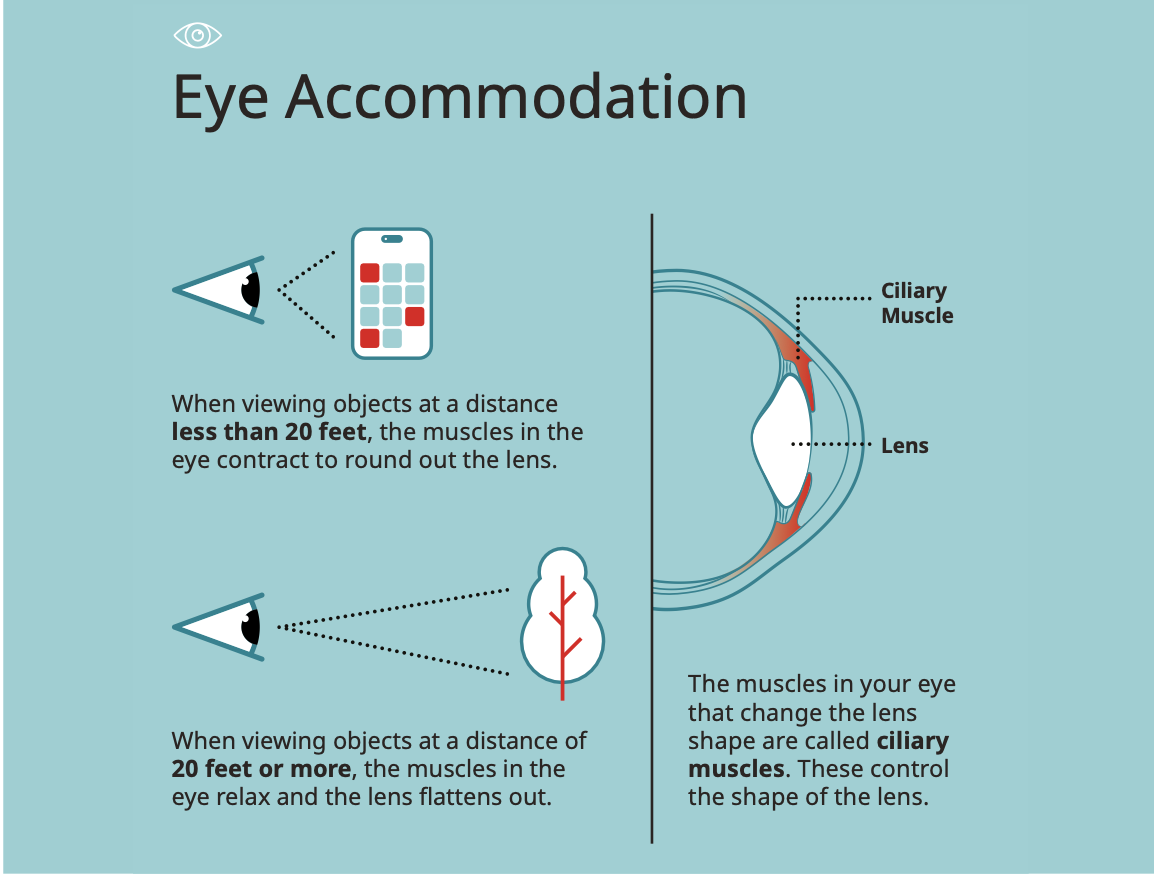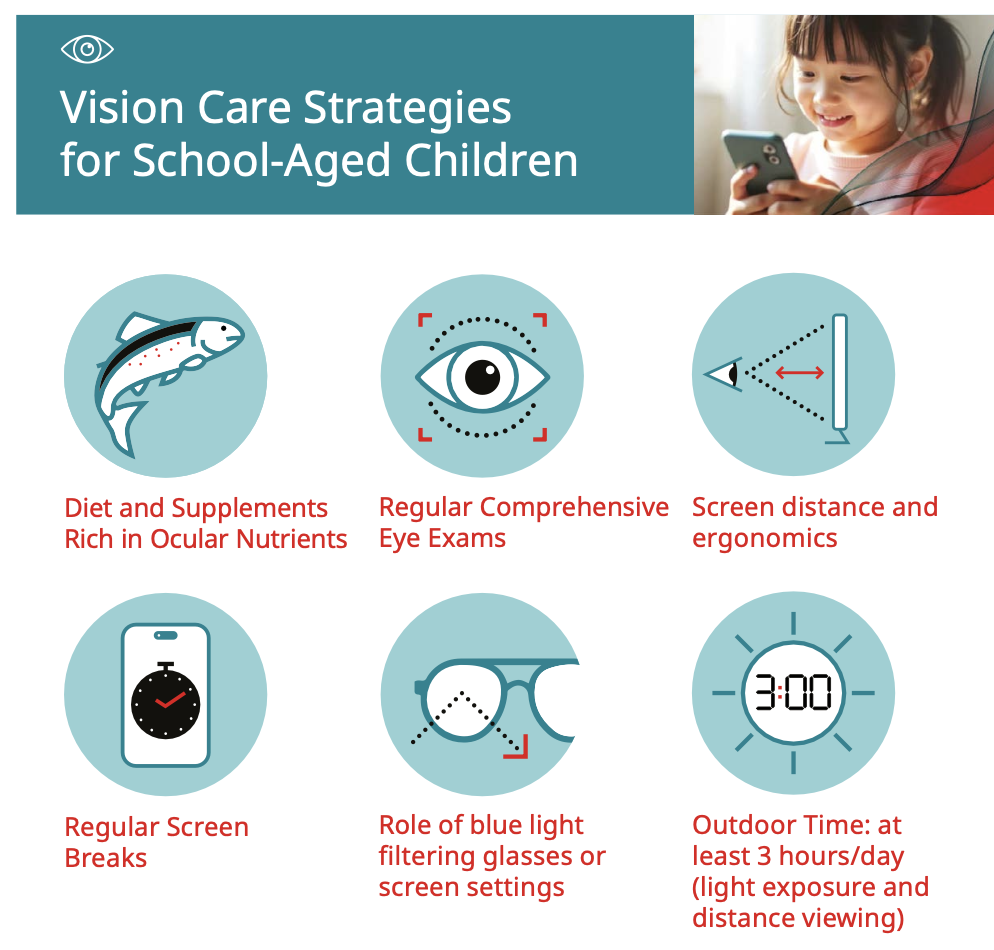With mounting evidence linking screen time to myopic progression, interest is growing in developing behavioral and nutritional vision care strategies to promote long-term ocular health in the digital age
The surge in screen time among children has raised significant concerns about its impact on eye health, with over half of school-aged children experiencing symptoms of computer vision syndrome (CVS).[1]
Eye care experts and parents note rising screen use and myopia
Pediatric optometry specialist Dr. Erin McCleary notes, “rising screen time, near work, and limited outdoor activity are accelerating both the onset and progression of myopia in children.” The global prevalence of myopia has increased by 66% over the past three decades, with nearly half the world projected to be myopic by 2050 [2, 3]. Pediatric ophthalmologist Dr. Austin Bach highlights that many parents feel powerless to limit screen time, as children spend much of their day on tablets at school.
However, vision care strategies, including regular eye exams, increased outdoor time, screen breaks, and a nutrient-rich diet, can empower families to manage their children’s eye health (Figure 1) [4].
“The AREDS and AREDS2 studies have shown that specific nutrients can have a positive effect on eye health,” explains Jeffrey R. Anshel, OD, FAAO [5, 6]. Nutrients such as lutein, omega-3s, antioxidant vitamins, and zinc support visual health, while recent research highlights astaxanthin as a promising carotenoid for reducing acute and chronic CVS symptoms [7, 8]. The resulting impact of nutritional support and CVS management on long-term vision is a critical area for future research.

The role of the ciliary body in accommodation and eye health
The ciliary body is essential for visual focusing, as it controls lens shape during accommodation (Figure 2). This continuous muscular effort, especially during prolonged near work, like reading or screen use, can lead to ciliary muscle fatigue and eye strain, common symptoms of CVS.
Dr. McCleary explains it this way, “screen exposure has a varied impact on the visual system. Primarily, it activates the accommodative (focusing) system. When this system is constantly engaged it can spasm, “locking” the visual system into a near-point focal distance.”
Imaging studies suggest that the ciliary body may be larger in myopic eyes, with more pronounced changes during near focus [9]. Overuse of ciliary muscles during close-up tasks may physically stretch the eye, increasing its axial length; triggering or worsening nearsightedness [10].
Nutritional strategies for developing eyes
During developmental years (ages 10–14), children’s eyes face intense accommodative demands, making proper nutrition essential for visual health [10, 11, 12]. Key nutrients like lutein, zeaxanthin, omega-3 fatty acids, and vitamins A, C, and E scavenge free radicals, support retinal health, and enhance visual performance [13, 14]. Astaxanthin complements these nutrients by providing unique antioxidant support to the ciliary body, combating digital eye strain and supporting accommodation [7]. Despite growing evidence of their benefits, many of these nutrients are absent from public health guidelines, underscoring the need for updated nutrition policies. Promoting balanced diets, school-based nutrition programs, and awareness of nutraceutical interventions can better support the visual health of the next generation in an increasingly digital world [8].
Astaxanthin: A powerful antioxidant for ocular health
Astaxanthin, a red-orange carotenoid with exceptional antioxidant properties, is naturally found in marine organisms like salmon and krill. Its unique ability to cross the blood-brain and blood-retina barriers makes astaxanthin a valuable addition to eye health protocols as managing free radicals plays an important role in supporting and maintaining eye health. Additionally, astaxanthin enhances ocular blood flow, benefiting the ciliary body by improving nutrient delivery and waste removal, which are essential for maintaining healthy vision [15, 16, 17].
The role of astaxanthin in accommodation
Astaxanthin’s antioxidant function, its deposition in the ciliary body, and in mitochondria are particularly impactful for accommodation and CVS resilience. By reducing oxidative stress and enhancing mitochondrial function, astaxanthin helps sustain the ciliary body’s energy demands during prolonged near work.
Studies in adults have shown that 4–12 mg/day of astaxanthin (AstaReal®) improved the range of focus, accommodation speed, and near-point focus, and reduced CVS symptoms [18, 19, 20, 21]. In children aged 10–14, 4 mg/day of astaxanthin (AstaReal®) reduced digital eye strain, improved stereovision, and increased lacrimation [7].
These findings highlight astaxanthin’s potential to maintain dynamic focus in times of high visual demand. Susan Hamrahi, N.D. remarks, “Vitamins A, C, E, omega-3s, lutein and zeaxanthin, are all important for supporting healthy vision in children, but I never recommend a vision supplementation protocol without astaxanthin. It’s the antioxidant critical for supporting eyes during screen time. Research now supports its place in pediatric eye care.”
Supplements supporting children’s vision
General multivitamins often lack key nutrients essential for children’s visual development, driving the growth of targeted eye health supplements (+2.97% CAGR, 2020–2024) [22]. Ocular nutrients support retinal health and accommodative function but often fall outside children’s RDIs [8, 23].
Market trends show growing popularity for tablets (+17.84%), powders (+1.8%), and innovative formats (+31.61%), while gummies, and chewables decline [22]. Parents favor tablets and powders for better taste, size, and dosing flexibility. Emerging methods like dispersible films and sprinkles are gaining traction, highlighting the need for tailored solutions for children’s nutrition and visual health in the digital age.


